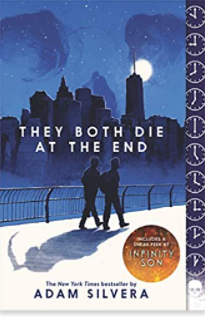Unexamined Living in the Race Against Time
They Both Die At The End
By Adam Silvera
Harper Teen, an Imprint of HarperCollins Publishers, 2018
400 pages
☼☼☼☼☼ — 5 out of 5 stars
No matter your need, Apple Corporation assured us in a nationally distributed 2009 commercial designed to sell the iPhone 3g, “There’s an app for that.” The marketing promotion was so successful that the phrase became one of the most enduring memes of the decade. Adam Silvera has taken this idea to its logical end in They Both Die in the End, where a service called Death-Cast calls everyone who is going to die on that day to alert them that their time is running out.
Mateo Torrez and Rufus Emeterio get the call, turn to their cell phones, of course, and become linked together through the Last Friend app, which provides a fittingly boon companion for your last day. It’s this unlikely pairing that provides the premise that drives the story in the novel, whose plot events, like a hybrid cross between “Death Race 2000” and “Bill and Ted’s Excellent Adventure,” never leave the reader lacking for energy, suspense, and interesting twists.
The future world of Silvera’s Young Adult fantasy (dare I call it a romp?) centers on the technology-encapsulated and cellphone-driven lives of young people. Mateo and Rufus, the two protagonists, are both socially handicapped misfits whose lives are like square pegs forced into round holes – things may look like they fit, but they don’t really. It takes the Death-Cast wake-up call to drive both to share a quest for what is truly important.
Readers and critics who rush to judge Young Adult fiction as juvenile and shallow would be making a mistake here: Silvera tackles nothing less than an existential and eternal question in his story – what gives our daily life meaning? So, much of the plot concerns their search for significant meaning in the short time that Mateo and Rufus have left. At first, they both turn away from their friends and families of election, looking to gadget filled techno-culture for support. But the many trendy manifestations they try, from virtual reality to rave clubs, come off as hit or miss. Ultimately, both re-embrace family and friends, and find what they are looking for in a hard fought and hard-won intimacy with one another.
The cast of characters in Silvera’s novel who get the call react in different ways. Their responses form the conflicts for storylines that Silvera weaves into a sensitive and masterful exposition of human behavior at its best and worst. The supporting characters form an interesting and diverse panoply around the two boys, and Silvera crafts his sub-plots for these characters as intersections with Mateo and Rufus, some of which they are aware of and some of which they aren’t. In this, Silvera draws on cinematic suspense tropes like those used by Joan Tewkesbury in her script for the 1975 film “Nashville,” and by writer Paul Haggis in his 2004 film “Crash,” where a group of diverse characters, seemingly unrelated, cross paths with each other in unexpected ways. Like the characters in Chaucer’s Canterbury Tales, these secondaries form a cross-section of humanity that Silvera uses to draw a stunning portrait of the human condition. They range from a young man who lives his last moments consumed in hate and obsessed with revenge to a woman whose denial leads her to waste her last day — and every type of personality in between. All of them connect and/or clash with Mateo and Rufus.
In the hands of a lesser writer such clashes might jar, but Silvera walks the reader along the tightrope between hope and certain doom with sure-footed style, never lapsing into moral gloom and doom, but never letting the reader forget that time is running out either. His conclusion seems to be that if we stop taking things for granted and earnestly examine our life, we will find joy enough, despite its brevity.
With engaging relatable characters, a suspenseful plot, and dramatic glimpses filled with laughter and tears, significance and absurdity, They Both Die At The End does a good job of convincing us that it’s not how much time you have left, it’s what you do with it that counts.
